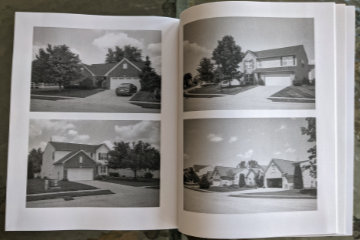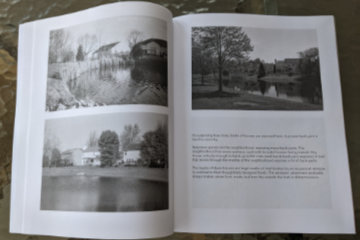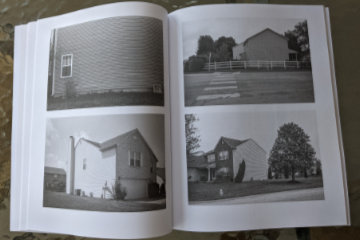 Jim Grey blogs, collects film cameras, uses those cameras, develops the film himself, walks, bikes, and observes. Put them together and what have you got? This book.
Jim Grey blogs, collects film cameras, uses those cameras, develops the film himself, walks, bikes, and observes. Put them together and what have you got? This book.
It’s a photo essay which is is something Grey has produced twice before; first in 2017’s Exceptional Ordinary then in 2018’s Textures of Ireland. There are technical differences between this and the earlier offerings that I’ll get to in a bit but I’ll first mention what seems to be the biggest departure. In the other two books, the photos were themselves the stars and their subjects of secondary importance. That’s not to say that it didn’t matter what appeared in the photographs but that the subject of the essay was not the subject of any of the pictures. An easy to describe aspect of that is the fact that each photo in the earlier books could stand alone. With Vinyl Village, they stand as a group. The subject of the pictures IS the subject of the essay.
That’s almost certainly what Grey means when he says, “I’ve never tried to tell a story with photographs before, not on this scale.” A photo essay is defined as “a group of photographs arranged to explore a theme or tell a story”. All three of Grey’s published photo essays explore a theme; only this one tells a story.
 It is a story about the neighborhood in which he lives, and where he interspersed COVID-triggered working-at-home with some calorie-burning walking-near-home. We are introduced to the neighborhood as a collection of modestly priced homes in an area of pricier residences. A big attraction is access to very good schools at somewhat bargain prices. Although the location makes them bargains, they are hardly shabby and actually look quite attractive — from the front.
It is a story about the neighborhood in which he lives, and where he interspersed COVID-triggered working-at-home with some calorie-burning walking-near-home. We are introduced to the neighborhood as a collection of modestly priced homes in an area of pricier residences. A big attraction is access to very good schools at somewhat bargain prices. Although the location makes them bargains, they are hardly shabby and actually look quite attractive — from the front.
 Construction is wood frame with vinyl siding and brick accents. Those accents, however, are almost entirely on the front of the houses. The other three sides are the focus of the story. Part of Grey’s story is about these sides being exposed by the curving streets, numerous retention ponds, and open spaces created by electric and gas lines.
Construction is wood frame with vinyl siding and brick accents. Those accents, however, are almost entirely on the front of the houses. The other three sides are the focus of the story. Part of Grey’s story is about these sides being exposed by the curving streets, numerous retention ponds, and open spaces created by electric and gas lines.
 The rest of the story is about those exposed surfaces and areas being a long way from handsome. The story’s name comes from the large expanses of vinyl siding exposed by those curves and ponds. Windows are few and from the outside often appear to be placed rather randomly and often awkwardly. Many side walls are unbroken by any windows at all.
The rest of the story is about those exposed surfaces and areas being a long way from handsome. The story’s name comes from the large expanses of vinyl siding exposed by those curves and ponds. Windows are few and from the outside often appear to be placed rather randomly and often awkwardly. Many side walls are unbroken by any windows at all.
 There are few words but lots of pictures. The pictures are black and white and large. The most common arrangement is two 4×6 inch photos to a page. Where words do appear, they typically share a page with one of those 4×6 photos. Occasionally a photo gets a page all to itself which lets it grow to approximately 5 1/2 by 8 1/4 inches. Grey has changed publishing platforms (from Blurb to Amazon) for this project which results in some physical differences from the previous essays. The pages are slightly smaller (8×10 vs 8.5×11) and the paper used is uncoated rather than semi-gloss. Photo quality does suffer but again it is the subject of the picture that is important. The pictures are here to document the subject and illustrate Grey’s story, not to be admired in and of themselves. It’s an assignment they handle quite well.
There are few words but lots of pictures. The pictures are black and white and large. The most common arrangement is two 4×6 inch photos to a page. Where words do appear, they typically share a page with one of those 4×6 photos. Occasionally a photo gets a page all to itself which lets it grow to approximately 5 1/2 by 8 1/4 inches. Grey has changed publishing platforms (from Blurb to Amazon) for this project which results in some physical differences from the previous essays. The pages are slightly smaller (8×10 vs 8.5×11) and the paper used is uncoated rather than semi-gloss. Photo quality does suffer but again it is the subject of the picture that is important. The pictures are here to document the subject and illustrate Grey’s story, not to be admired in and of themselves. It’s an assignment they handle quite well.
Jim handles his own assignment, that of telling a story with pictures, quite well also. Beauty may be only skin deep and curb appeal only as thick as a brick but that can be enough if a great personality or a highly rated school is involved.
Vinyl Village, Jim Grey, Midnight Star Press (October 16, 2021), 8 x 10 inches, 64 pages, ISBN 979-8498035475
Available through Amazon.

Hey wow, thank you for this review!
You’re quite welcome although the number of readers isn’t likely to make even a small bump in sales unless every one of them buys multiple copies. Nice job on the book.
Pingback: Book Review Square Photographs Jim Grey | Denny G's Road Trips Blog